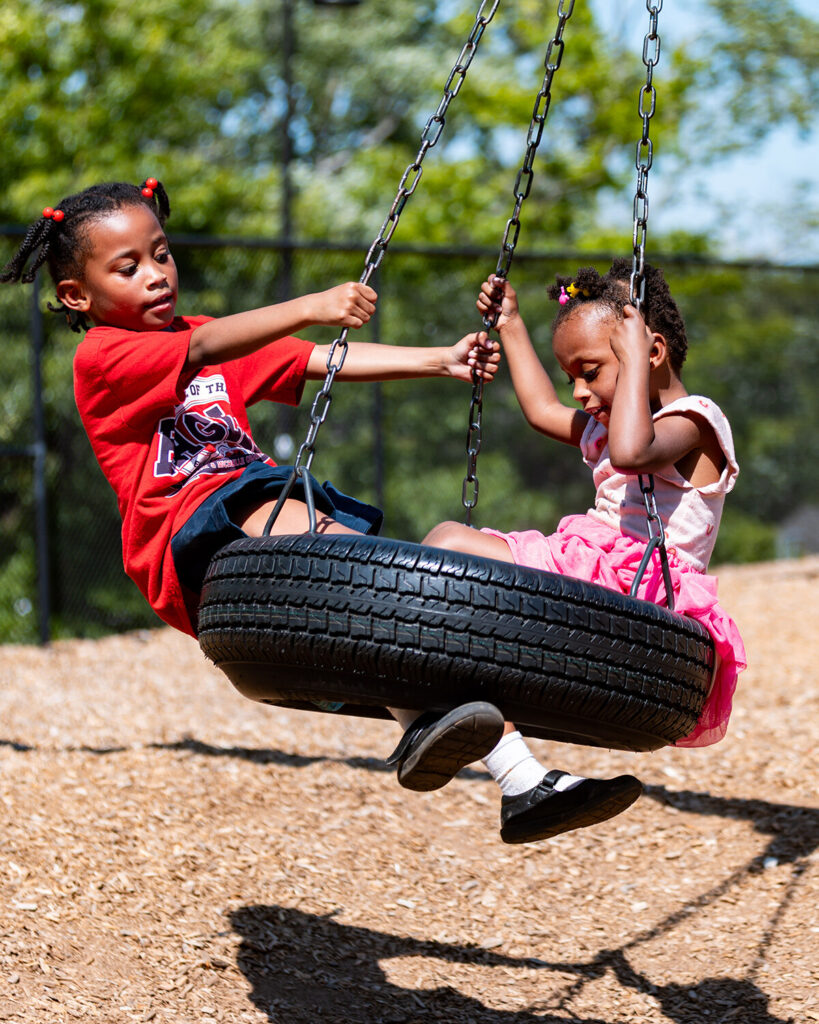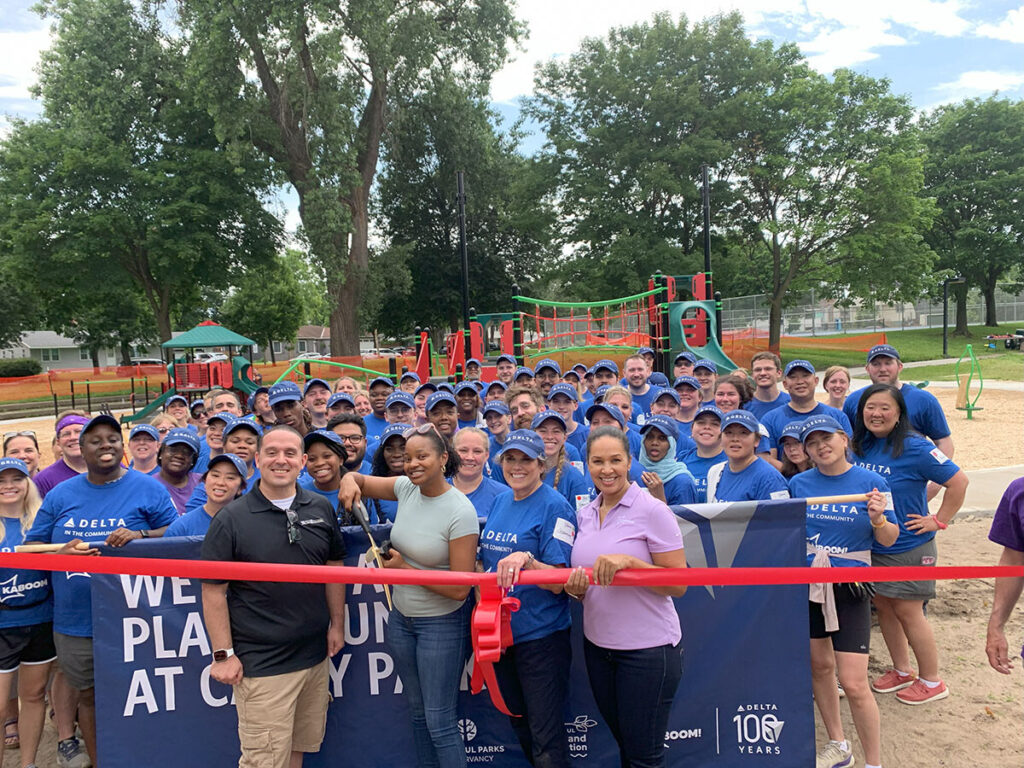Each summer, the familiar sounds of kids racing outside to play fill the air. Families and neighbors gather outdoors in parks, at playgrounds, and in nature to enjoy much needed leisure time away from the mounting stressors of school, work, and the news. Outdoor play improves health, learning, and community connection, but in under-resourced neighborhoods, access to quality places to play may be out of reach.
What steps can city leaders take to expand opportunities for play this summer and into the future?
At a time when the very nature of childhood is shifting and all age groups are spending more hours looking at screens or overly committed to scheduled activities, city leaders can play a powerful role by creating viable alternatives that get kids outside and active. Four cities are spotlighted below as examples of how to make outdoor play more accessible and equitable across the country
Engage Local Advocates to Build Momentum – Rochester, NY
In Rochester, a grassroots network of parents, youth, and community groups–Healthi Kids–has transformed the conversation around outdoor play through its PlayROCs initiative. Champions at the community level have grown into leadership roles through hosting play events, advocating at city hall, and partnering on traffic calming efforts.
For 11 year old Arwyn, advocating for play is a family legacy. Her mother Heather got involved in play advocacy through early programming with local group Healthi Kids. Arwyn began speaking out at local meetings about the importance of play when she was just four years old. Inspired by her family and the broader community of advocates in Rochester, Arwyn has grown into a confident voice for children’s rights. Most recently, she traveled to Washington, D.C., where she spoke on Capitol Hill to national leaders about protecting funding for play.
Arwyn’s journey reflects how sustained community engagement can plant seeds of leadership that grow across generations, and how local advocacy can ripple outward to influence state and national conversations. City leaders took note. Early wins like a Play Streets pilot led to policy shifts that now allow residents to independently organize street closures for play.
Rochester’s leaders also regularly consult local advocates on public space projects, embedding play equity into planning processes like the city’s 2034 Comprehensive Plan. As one advocate shared, “Our work has helped city leaders see the long-term value of play—and how responsive, community-led initiatives can drive systems change.”
Use Data to Drive Smarter Investments – Fort Worth, TX
In Fort Worth, data was a catalyst for equity. A playspace quality assessment conducted with KABOOM! provided local decision makers with a baseline understanding of conditions across elementary school playgrounds. When district leaders layered in indicators like student achievement and neighborhood disinvestment, clear patterns emerged: some schools lacked quality play areas and students attending these identified schools would benefit most from reinvestment.
The district developed a comprehensive playspace replacement schedule grounded in equity and urgency. Visual maps helped bring disparities to life, while equity overlays and student outcome data helped make the case for prioritizing the schools most in need of investment. Already, the data has guided facility upgrades and empowered principals and facilities teams to advocate for resources using a shared, data-informed framework.
Fort Worth’s experience shows how cities can turn insight into action. Data revealed not only where investment was needed, but how it could help support academic, health, and neighborhood outcomes as well.
Align Policies and Practices to Expand Access – Atlanta, GA
In Atlanta, leaders are using joint use policies to unlock schoolyards for community play after hours. Through the Atlanta Community School Parks Initiative, a coalition of partners from the City of Atlanta, Atlanta Public Schools, and five non-profit partners (Trust for Public Land, KABOOM!, the Cities Connecting Children to Nature Initiative, a partnership of the Children & Nature Network and the National League of Cities, and Out Teach), the City and School district formalized a joint use agreement to unlock a shared used for schoolyards and recreation facilities.

The idea was sparked at a Children and Nature Network National Conference, where the Atlanta team participated through the Cities Connecting Children to Nature Program. Here they saw that shared-use agreements could actually be simple to implement, the agreement will open schoolyards to more than 19,000 Atlantans, many of whom currently lack walkable access to parks.
Atlanta’s approach shows how policy alignment is key. From co-investing in nature-based schoolyards to streamlining maintenance protocols, collaboration across agencies ensures that shared spaces serve whole communities. Atlanta offers a replicable model as cities consider similar strategies.
Get Creative About Funding – Saint Paul, MN

In 2023, Saint Paul residents voted to approve a 1% local sales tax branded the “Common Cent Saint Paul” initiative to fund improvements to roads and parks. This bold investment will generate nearly $1 billion over 20 years, with $246 million earmarked for park upgrades, including playspaces
It was a long time coming. After decades of deferred maintenance and aging facilities, city leaders led by Mayor Melvin Carter made the case that both residents and visitors benefit from safe, vibrant public spaces. With broad community support and political will, the city now has a stable funding stream for maintaining and revitalizing park infrastructure.
Already, Saint Paul Parks and Rec has partnered with KABOOM! and others to rebuild playgrounds like Hayden Heights Park, where families co-designed new play features and volunteers came together to bring the space to life. This summer, upgrades are also planned for Taylor Park, Carty Park, and Linwood Rec Center. With a growing population and an aging park system, these improvements will ensure that play remains accessible to all.
Every City Must Act
These examples demonstrate that cities don’t have to start from scratch when working to expand access to high-quality places for play. Whether by embracing community leadership, leveraging data, aligning policies, or finding creative funding streams, every municipality has tools to make play more equitable.
KABOOM! works alongside city leaders, school districts, and community organizations to advance these strategies nationwide. Interested in learning more or starting this work in your city? Reach out to us or sign up for our 25 in 5 newsletter to stay connected to stories and strategies driving playspace equity across the country.
Interested In Learning More About Our Work?
Check out some of our latest stories!
-
Building More Than a Playground in Historic Eatonville: A Legacy of Greatness, A Future of Hope
Earlier this year, something extraordinary happened in the heart of Eatonville, Florida that brought together a historic town, a passionate community, and more than 150…
-
New Design Toolkit for Enriching Outdoor Playspaces for our Youngest Learners
The KABOOM! Early Childhood Playspace Design Toolkit is a new resource that empowers early learning providers, city leaders, and planners with tools to create developmentally-appropriate outdoor environments that help children ages 0 to 5 grow and thrive.
-
Counting Play: How KABOOM! Uses Crowdsourced Mobile GPS Data to Understand Playground Use
Playgrounds are more than just places for kids to have fun—they are critical community spaces that contribute to health, well-being, and social connection. Decision-makers need…
